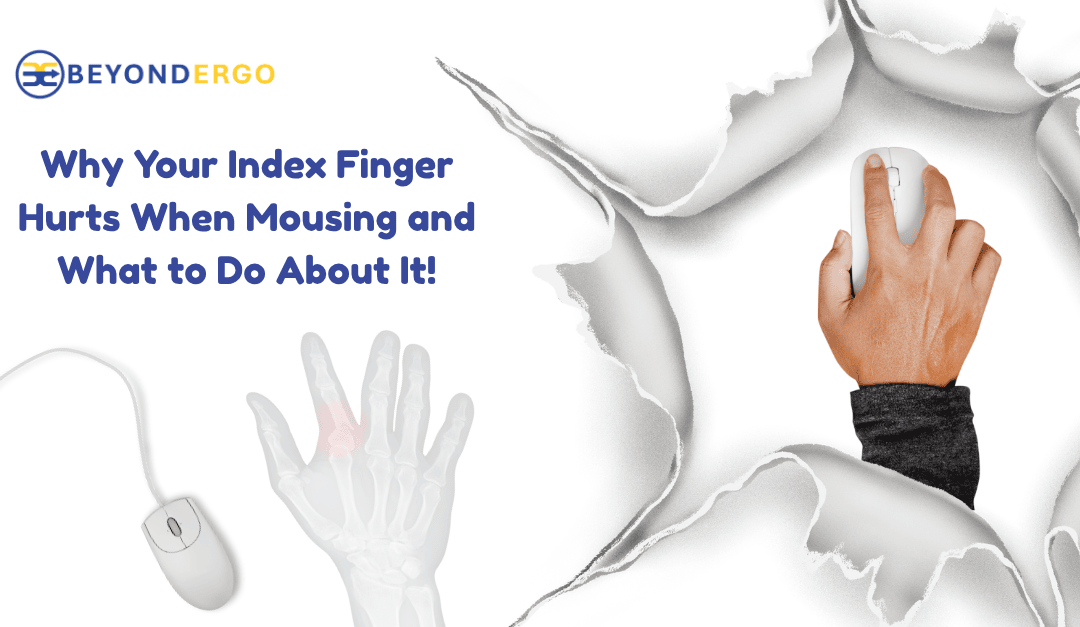If you’ve noticed a stiff, aching, or tingling index finger from hours of clicking or scrolling, you’re far from alone. Thousands of Australians experience index finger pain from computer use. Left unmanaged, this discomfort can escalate into chronic stiffness, swelling, or even loss of grip strength. This discomfort is often a sign of early sign of:
- Repetitive Strain Injury (RSI) – micro-damage from continual motion, causing stiffness or aching.
- Carpal Tunnel Syndrome – compression of the median nerve, with numbness or tingling in the thumb and index fingers.
- Finger Tendinitis or Trigger Finger – irritation or locking of finger tendons from repetitive gripping.
(Visit: Beyond Ergo – Avoid Index Finger Tendonitis for more details)
The Hidden Costs of Finger Pain at Work
A sore finger might sound minor, but it can quietly drain productivity, accuracy, and comfort.
Every click adds up. Over the course of a single week, your index finger performs tens of thousands of micro-movements — far more than the tendons were designed to handle without rest.
At Beyond Ergo, our research shows a steady rise in index finger tendinitis as device use increases. The combination of speed, pressure, repetition, and lack of recovery time makes office and contact centre workers particularly vulnerable.
Poor posture compounds the problem. Slouched sitting, awkward wrist angles, or excessive clicking force all strain tendons and compress nerves. Over time, these small stresses accumulate into pain, tingling, or stiffness in the index finger and hand.
Use our Work-from-Home Ergonomic Checklist to identify risks and improve your setup.
Don’t Ignore “Minor” Pain
Overuse injuries don’t discriminate by age or profession — and what starts as a small irritation can quickly escalate.
Take this example:
A young accountant, just two years out of university, began feeling shooting pains in his right arm. He saw a physiotherapist and switched to using his mouse with his left hand. Soon, the left hand developed the same shooting pains, accompanied by worsening neck pain.
The problem? No one had assessed his posture, and he couldn’t properly implement his company’s ergonomic checklist on his own. What began as arm pain evolved into a systemic neck issue, eventually triggering chronic headaches.
This progression isn’t unusual. Poor computer posture creates a cascade effect: tension starts in the neck and radiates down through the hand, compressing nerves and straining muscles. The result often shows up as index finger pain—a symptom at the end of a much longer chain.
Read more about “A Frightening Trend” article.
How to Relieve and Prevent Index Finger Pain
The Good News: Small, regular changes can drastically reduce discomfort and prevent long-term injury. Beyond Ergo’s programs, building ergonomist behaviours recommend the following strategies:
- 🕒 Take a 30-second reset every hour. Stretch your fingers, open and close your hands, and rotate your wrists.
- 💪 Keep wrists straight and shoulders relaxed. Aim for elbows at about 90 degrees.
- 🖱️ Adjust your mouse and keyboard to maintain neutral wrist alignment.
- ⚙️ Use ergonomic tools. Try split keyboards, vertical mice, or wrist supports.
- 🔁 Alternate hands for clicking and scrolling to share the load.
- ⌨️ Use keyboard shortcuts (e.g., Ctrl+C to copy, Alt+Tab to switch windows) to reduce repetitive mouse use.
- 🖐️ Find a mouse that fits your hand. The right size and shape can make a huge difference in comfort.
- 🧍♀️ Move more often. Use Beyond Ergo’s Roll–Reset–Relax micro-break to ease tension and restore posture.
Download our Stretch Sheet for simple daily exercises.
Discover more ways to Avoid Computer-Related Pain page.
The Bigger Picture — Why Movement Matters
Your bodies don’t work in isolation. Finger, wrist, and shoulder discomfort are all part of one system that reacts to how long we sit and how often we move.
Moving more is the key.
Using the Roll-Reset-Relax micro break quickly releases the muscle tension that builds as we work on computers. It also helps build postural mindfulness to reset our posture to a relaxed and neutral position, which is important. Taking a brisk 10-minute walk during a break is an aerobic exercise that helps relax muscles and promote recovery. It is also beneficial for neck and shoulder pain by reducing tension and increasing circulation, which helps the finger tendons heal faster.
✨ (Download our Roll-Reset-Relax sheet with instructions.)
When to Seek Help
If your symptoms include persistent numbness, tingling, or swelling, or pain that radiates into your hand or arm, it’s time to seek ergonomic or medical support. Early assessment leads to faster recovery and prevents chronic injury.
Discover More
- ✨ Learn more simple, no-cost ways to improve your comfort and productivity at the Beyond Ergo Small Changes Project page.
- ✨ Or book an obligation-free consultation to understand how tailored ergonomic changes can reduce pain and increase team wellbeing.
- ✨ Visit this blog to learn more about: Beyond Ergo – Avoid Index Finger Tendonitis
💡 Enjoyed this post?
Subscribe to our monthly newsletter for fresh insights and Beyond Ergo updates — straight to your inbox.

